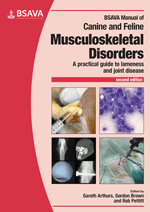
Full text loading...

For the purposes of this manual, the term ‘arthritis’ is used to bring together the diagnosis and management of the disease processes involved in three main categories of joint disease: namely osteoarthritis, immune-mediated polyarthritis and infective arthritis. This chapter describes the classification, pathology, clinical presentation, diagnosis, treatment and prognosis of arthritis.
Arthritis, Page 1 of 1
< Previous page | Next page > /docserver/preview/fulltext/10.22233/9781910443286/9781910443286.6-1.gif

Full text loading...



















